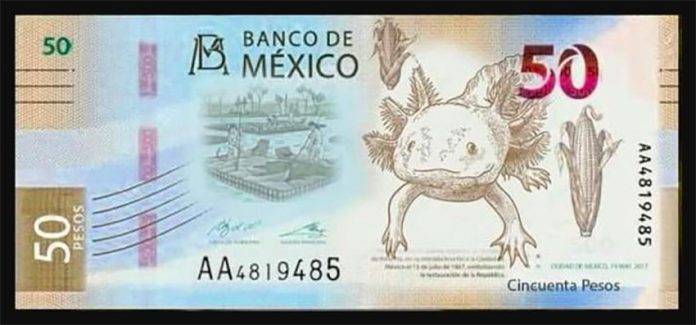The axolotl, a species of salamander endemic to Mexico City’s Lake Xochimilco, may be endangered but it recently got some news that could give it something to smile about.
The Bank of México (Banxico) announced that the amphibian will grace the new series of 50-peso notes to be put into circulation in 2022.
Accompanying the grinning creature will be an ear of corn and an image of farmers tending crops on the famous chinampas, or manmade islands used for agriculture.
The obverse side of the bill will feature an image commemorating the founding of Tenochtitlán, the capital of the Aztec empire at the time of the arrival of the Spanish.
Two banknotes in the new family of bills planned by Banxico have already been put into circulation. The new 500-peso note began confusing citizens in August 2018 with its resemblance to the 20-peso note: blue-colored and donning the face of beloved 19th-century president Benito Juárez.
The new 200-peso note went into circulation in September of last year. It’s still green, but switched out the face of feminist poet Sister Juana Inés de la Cruz for those of Mexican independence heroes Miguel Hidalgo and José María Morelos.
But fans of “The Tenth Muse,” as De la Cruz is affectionately called, need not worry, for she isn’t gone for good. She will adorn the new 100-peso note. Opposite her face will be an image of the Monarch Butterfly Biosphere Reserve in Michoacán and México state.
The new 1,000-peso note will feature the 33rd president of Mexico, Francisco I. Madero, Revolution-era feminist Hermila Galindo and revolutionary Carmen Serdán. A jaguar will stalk its reverse side next to an image of the ancient Mayan city of Calakmul.
Banxico has plans for a possible 2,000-peso bill, but it will only be released if economically necessary. Should it be put into circulation, poets Octavio Paz and Rosario Castellanos will be on the bill.
The new family of bills will soon lose a member, as Banxico is planning to gradually take the 20-peso note out of circulation and replace it with a coin. It will both commemorate Mexican independence and enshrine the crocodiles and mangrove forests of the Sian Ka’an Biosphere Reserve in Quintana Roo.
Source: El Universal (sp)
